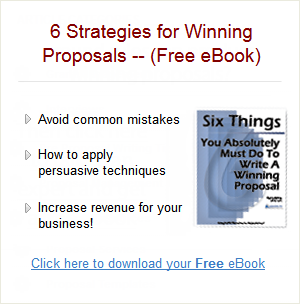Who are Your Readers: The Economic Buyer
Economic buyers are the “money” people in the client’s organization. They control the budget and have veto power over any decision requiring spending. They will take a hard look at the return on their investment and they want to make sure they get the best deal for the organization.
Who they are and what they look for. Simply put, the economic buyer is the one who has authority to make the purchase for which you are proposing. For major projects, the economic buyers are almost always in an upper echelon management position-agency director, (e.g., Director of Public Works), division director (e.g., VP for Operations in a privately held company), or perhaps a group of people (e.g., a school board).
Whatever the title, people serving in this role have at least two things in common:
1.) they are more interested in the big picture than they are in the details, and
2.) they are too busy to read the details anyway. This means that if they read your proposal at all, they’ll only skim it. They may read the executive summary (or cover letter, if that’s what serves as your executive summary), but that isn’t a sure bet either. Even then they just may skim over it.
In most procurements, the economic buyer relies heavily on subordinates to summarize their findings about the proposals under review and make recommendations. Those who give these summaries will know what their bosses are looking for in the way of big picture issues and associated benefits. So while the economic buyer herself may not read the proposal, you can bet that someone is reading with an eye to see if you have hit on her main concerns.
Your job, of course, is to make sure you discover what those concerns are and make sure you hit them.
How to write for them. Give them sound bites. The economic buyer is busy; she doesn’t have time to wade through a bunch of details to get at what she considers the meat of your proposal. You have to present you key selling points in bit-sized pieces that make the point quickly. You have to make statements like this:
How to write for them. Give them sound bites. The economic buyer is busy; she doesn’t have time to wade through a bunch of details to get at what she considers the meat of your proposal. You have to present you key selling points in bit-sized pieces that make the point quickly. You have to make statements like this:
“Our approach will reduce the cost of operating and maintaining the facility by up to 10% per year.”
“Our in-depth knowledge of your facility will allow us to meet the key project milestones necessary for you to make the federal matching funds deadline.”
“We’ve tailored our management approach to make sure that the District maintains control of the project and is the key player in all major decisions.”
Statements like these will make the economic buyer sit up and take notice. Of course, they have to be based on what you know are the economic buyer’s hot buttons. They must be delivered–in no uncertain terms, without qualification–up front in the executive summary, cover letter or introduction so that it arrests the reader’s attention and makes them want to read further.
You must stress the benefits of your offer-how what you will do gives the economic buyer something she greatly values. This means that you have to get into the client’s shop and talk with the chief decision maker and find out what it is she values.
You need to make it visual. Remember, they’re busy; graphics draw their attention and might be all they look at in your proposal. Use bullets, call-out boxes, and colorful high-concept graphics to send your message.

